-

新人教版高中英语选修2Unit 3 Reading for writing教学设计
The theme of this part is to write an article about healthy diet. Through reading and writing activities, students can accumulate knowledge about healthy diet, deepen their understanding of the theme of healthy diet, and reflect on their own eating habits. This text describes the basic principles of healthy diet. The author uses data analysis, definition, comparison, examples and other methods. It also provides a demonstration of the use of conjunctions, which provides important information reference for students to complete the next collaborative task, writing skills, vivid language materials and expressions.1. Teach Ss to learn and skillfully use the new words learned from the text.2. Develop students’ ability to understand, extract and summarize information.3. Guide students to understand the theme of healthy diet and reflect on their own eating habits.4. To guide students to analyze and understand the reading discourse from the aspects of theme content, writing structure, language expression, etc., 5. Enable Ss to write in combination with relevant topics and opinions, and to talk about their eating habits.1. Guide students to analyze and understand the reading discourse from the aspects of theme content, writing structure, language expression, etc.2. Enable them to write in combination with relevant topics and opinions, and to talk about their eating habits.3. Guide the students to use the cohesive words correctly, strengthen the textual cohesion, and make the expression fluent and the thinking clear.Step1: Warming upbrainstorm some healthy eating habits.1.Eat slowly.2.Don’t eat too much fat or sugar.3.Eat healthy food.4.Have a balanced diet.Step2: Read the passage and then sum up the main idea of each paragraph.

新人教版高中英语选修2Unit 2 Reading for writing教学设计
The theme of this section is to express people's views on studying abroad. With the continuous development of Chinese economic construction, especially the general improvement of people's living standards, the number of Chinese students studying abroad at their own expense is on the rise. Many students and parents turn their attention to the world and regard studying abroad as an effective way to improve their quality, broaden their horizons and master the world's advanced scientific knowledge, which is very important for the fever of going abroad. Studying abroad is also an important decision made by a family for their children. Therefore, it is of great social significance to discuss this issue. The theme of this section is the column discussion in the newspaper: the advantages and disadvantages of studying abroad. The discourse is about two parents' contribution letters on this issue. They respectively express their own positions. One thinks that the disadvantages outweigh the advantages, and the other thinks that the advantages outweigh the disadvantages. The two parents' arguments are well founded and logical. It is worth noting that the two authors do not express their views on studying abroad from an individual point of view, but from a national or even global point of view. These two articles have the characteristics of both letters and argumentative essays1.Guide the students to read these two articles, and understand the author's point of view and argument ideas2.Help the students to summarize the structure and writing methods of argumentative writing, and guides students to correctly understand the advantages and disadvantages of studying abroad3.Cultivate students' ability to analyze problems objectively, comprehensively and deeply

新人教版高中英语选修2Unit 2 Using langauge-Listening教学设计
? B: Absolutely! Getting involved with Chinese cultural activities there definitely helped a lot. I got to practice my Chinese on a daily basis, and I could learn how native Chinese speakers spoke.? A: What do you feel is your biggest achievement?? B: Learning Chinese characters! I have learnt about 1,500 so far. When I first started, I didn't think it was even going to be possible to learn so many, but now I find that I can read signs, menus, and even some easy newspaper articles.? A: What are you most keen on?? B: I've really become keen on learning more about the Chinese culture, in particular Chinese calligraphy. As I have learnt Chinese characters, I have developed a great appreciation for their meaning. I want to explore Chinese characters by learning how to write them in a more beautiful way. ? A: Finally, what do you want to say to anyone interested in learning Chinese?? I have really become keen on learning more about the Chinese culture, in particular Chinese Calligraphy. As I have learnt Chinese character, I have developed a great appreciation for their meaning. I want to explore Chinese characters by learning how to write them in a more beautiful way.? A: Finally, what do you want to say to anyone interested in learning Chinese?? B: I'd say, give it a shot! While some aspects may be difficult, it is quite rewarding and you will be happy that you tried.? A: Thanks for your time. ? B:You're welcome.

新人教版高中英语选修2Unit 3 Using langauge-Listening教学设计
1. How is Hunan cuisine somewhat different from Sichuan cuisine?The heat in Sichuan cuisine comes from chilies and Sichuan peppercorns. Human cuisine is often hotter and the heat comes from just chilies.2.What are the reasons why Hunan people like spicy food?Because they are a bold people. But many Chinese people think that hot food helps them overcome the effects of rainy or wet weather.3.Why do so many people love steamed fish head covered with chilies?People love it because the meat is quite tender and there are very few small bones.4.Why does Tingting recommend bridge tofu instead of dry pot duck with golden buns?Because bridge tofu has a lighter taste.5 .Why is red braised pork the most famous dish?Because Chairman Mao was from Hunan, and this was his favorite food.Step 5: Instruct students to make a short presentation to the class about your choice. Use the example and useful phrases below to help them.? In groups of three, discuss what types of restaurant you would like to take a foreign visitor to, and why. Then take turns role-playing taking your foreign guest to the restaurant you have chosen. One of you should act as the foreign guest, one as the Chinese host, and one as the waiter or waitress. You may start like this:? EXAMPLE? A: I really love spicy food, so what dish would you recommend?? B: I suggest Mapo tofu.? A: Really ? what's that?

新人教版高中英语选修2Unit 4 Learning about Language教学设计
This section guides students to pay attention to the typical context of vocabulary use, helps students accumulate vocabulary around the key vocabulary of this unit, and uses the learned words and word chunks in different contexts to deeply understand their meaning and usage, so as to achieve the purpose of review and consolidation.The teaching design activities aim to guide students to pay attention to the typical context in which the target vocabulary is used, as well as the common vocabulary used in collocation, so that students can complete the sentence with correct words. In terms of vocabulary learning strategies, this unit focuses on cultivating students' ability to pay attention to collocation of words and to use word blocks to express meaning.For vocabulary learning, it is not enough just to know the meaning of a single word, but the most important thing is to master the common collocations of words, namely word blocks.Teachers should timely guide students to summarize common vocabulary collocation, such as verb and noun collocation, verb and preposition collocation, preposition and noun collocation, and so on.1. Guide students to understand and consolidate the meaning and usage of the vocabulary in the context, 2. Guide the students to use the unit topic vocabulary in a richer context3. Let the students sort out and accumulate the accumulated vocabulary, establishes the semantic connection between the vocabulary,4. Enable students to understand and master the vocabulary more effectivelyGuiding the Ss to use unit topic words and the sentence patterns in a richer context.

新人教版高中英语选修2Unit 4 Reading for writing教学设计
假定你是英国的Jack,打算来中国旅行,请你给你的中国笔友李华写一封信,要点如下:1.你的旅行计划:北京→泰山→杭州;2.征求建议并询问他是否愿意充当你的导游。注意:1.词数80左右(开头和结尾已给出,不计入总词数);2.可以适当增加细节,以使行文连贯。参考词汇:故宫 the Forbidden City;泰山 Mount TaiDear Li Hua,I'm glad to tell you that 'm going to visit China.First,I am planning to visit Beijing,the capitalof China,where I am looking forward to enjoying the Great Wall,the Forbidden City and somebeautiful parks.Then I intend to go to visit Mount Tai in Shandong Province.I've heard that it is one ofthe most famous mountains in China and I can't wait to enjoy the amazing sunrise there.After that,I amalso going to Hangzhou.It is said that it is a beautiful modern city with breathtaking natural sights,among which the West Lake is a well- known tourist attraction.What do you think of my travel plan? Will you act as my guide? Hope to hear from you soon.

新人教版高中英语选修2Unit 4 Using langauge-Listening教学设计
The theme of the listening section is " talking about scenery and culture along a journey."The part is designed to further lead the students to understand Canadian natural geography and social environment, and integrated into the cultural contrast by mentioning the long train journey from Beijing to Moscow routes. On this basis, the part activates students related travel experience, lets the student serial dialogue, guides the student to explore further the pleasure and meaning of the long journey, and Chinese and foreign cultural comparison.The part also provides a framework for the continuation of the dialogue, which is designed to provide a framework for students to successfully complete their oral expressions, and to incorporate an important trading strategy to end the dialogue naturally.1. Help students to understand and master some common English idioms in the context, and experience the expression effect of English idioms.2. Guide the students to understand the identity of different people in the listening context, and finish the dialogue according to their own experience.3. Instruct the students to use appropriate language to express surprise and curiosity about space and place in the dialogue, and master the oral strategy of ending the dialogue naturally.1. Instruct students to grasp the key information and important details of the dialogue.2. Instruct students to conduct a similar talk on the relevant topic.

新人教版高中英语选修2Unit 5 Learning about Language教学设计
The purpose of this section of vocabulary exercises is to consolidate the key words in the first part of the reading text, let the students write the words according to the English definition, and focus on the detection of the meaning and spelling of the new words. The teaching design includes use English definition to explain words, which is conducive to improving students' interest in vocabulary learning, cultivating their sense of English language and thinking in English, and making students willing to use this method to better grasp the meaning of words, expand their vocabulary, and improve their ability of vocabulary application. Besides, the design offers more context including sentences and short passage for students to practice words flexibly.1. Guide students to understand and consolidate the meaning and usage of the vocabulary in the context, 2. Guide the students to use the unit topic vocabulary in a richer context3. Let the students sort out and accumulate the accumulated vocabulary, establishes the semantic connection between the vocabulary,4. Enable students to understand and master the vocabulary more effectivelyGuiding the Ss to use unit topic words and the sentence patterns in a richer context.Step1: Read the passage about chemical burns and fill in the blanks with the correct forms of the words in the box.

新人教版高中英语选修2Unit 5 Reading and thinking教学设计
The theme of this activity is to learn the first aid knowledge of burns. Burns is common in life, but there are some misunderstandings in manual treatment. This activity provides students with correct first aid methods, so as not to take them for granted in an emergency. This section guides students to analyze the causes of scald and help students avoid such things. From the perspective of text structure and collaborative features, the text is expository. Expository, with explanation as the main way of expression, transmits knowledge and information to readers by analyzing concepts and elaborating examples. This text arranges the information in logical order, clearly presents three parts of the content through the subtitle, accurately describes the causes, types, characteristics and first aid measures of burns, and some paragraphs use topic sentences to summarize the main idea, and the level is very clear.1. Guide students to understand the causes, types, characteristics and first aid methods of burns, through reading2. Enhance students’ ability to deal withburnss and their awareness of burns prevention3. Enable students to improve the ability to judge the types of texts accurately and to master the characteristics and writing techniques of expository texts.Guide students to understand the causes, types, characteristics and first aid methods of burns, through readingStep1: Lead in by discussing the related topic:1. What first-aid techniques do you know of ?CPR; mouth to mouth artificial respiration; the Heimlich Manoeuvre

新人教版高中英语选修2Unit 5 Using langauge-Listening教学设计
The theme of this section is to learn how to make emergency calls. Students should learn how to make emergency calls not only in China, but also in foreign countries in English, so that they can be prepared for future situations outside the home.The emergency telephone number is a vital hotline, which should be the most clear, rapid and effective communication with the acute operator.This section helps students to understand the emergency calls in some countries and the precautions for making emergency calls. Through the study of this section, students can accumulate common expressions and sentence patterns in this context. 1.Help students accumulate emergency telephone numbers in different countries and learn more about first aid2.Guide the students to understand the contents and instructions of the telephone, grasp the characteristics of the emergency telephone and the requirements of the emergency telephone.3.Guide students to understand the first aid instructions of the operators.4.Enable Ss to make simulated emergency calls with their partners in the language they have learned1. Instruct students to grasp the key information and important details of the dialogue.2. Instruct students to conduct a similar talk on the relevant topic.Step1:Look and discuss:Match the pictures below to the medical emergencies, and then discuss the questions in groups.
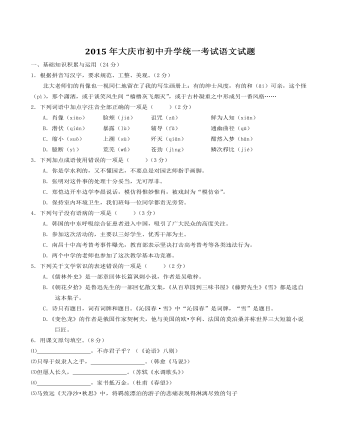
2015年中考真题精品解析 语文(黑龙江大庆卷)精编word版(原卷版)
①2014年年中,世界卫生组织(WHO)公布了《2013年全球气候状况报告》。报告显示,2013年全球陆地和海洋表面平均温度为14.5℃,比1961-1990年的平均温度升高0.5℃。自有温度记录以来,全球14个最热年份中有13个出现在本世纪,而过去30年中每个10年都比前十年更热。②厄尔尼诺是发生在热带太平洋上海温异常增暖的气候现象,大范围热带太平洋增暖会造成全球气候变化。进入20世纪70年代后,全球出现的异常天气,都有范围广、灾情重、时间长等特点,而在这一系列异常天气的背后,厄尔尼诺暖流都起着重要作用。
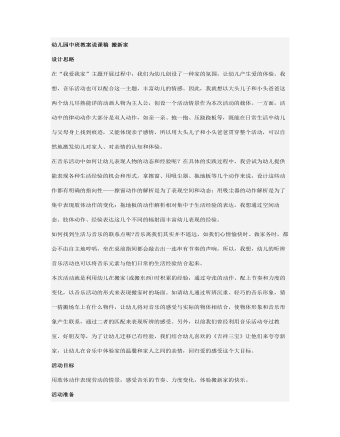
幼儿园中班教案说课稿 搬新家
在“我爱我家”主题开展过程中,我们为幼儿创设了一种家的氛围,让幼儿产生爱的体验。我想,音乐活动也可以配合这一主题,丰富幼儿的情感。因此,我就想以大头儿子和小头爸爸这两个幼儿耳熟能详的动画人物为主人公,创设一个活动情景作为本次活动的载体。一方面,活动中的律动动作大部分是双人动作,如亲一亲、抱一抱、压跷跷板等,既能在日常生活中幼儿与父母身上找到痕迹,又能体现亲子感情,所以用大头儿子和小头爸爸贯穿整个活动,可以自然地激发幼儿对家人、对亲情的认知和体验。
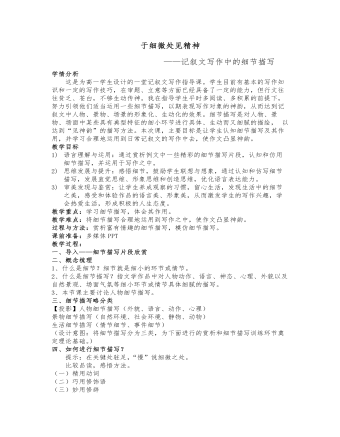
高中语文作文课教案说课稿模板
教学目标1) 语言理解与运用:通过赏析例文中一些精彩的细节描写片段,认知和仿用细节描写,并运用于写作之中。2) 思维发展与提升:感悟细节,鼓励学生联想与想象,通过认知和仿写细节描写,发展直觉思维、形象思维和创造思维,优化语言表达能力。3) 审美发现与鉴赏:让学生养成观察的习惯,留心生活,发现生活中的细节之美,感受和体验作品的语言美、形象美,从而激发学生的写作兴趣,学会热爱生活,形成积极的人生态度。
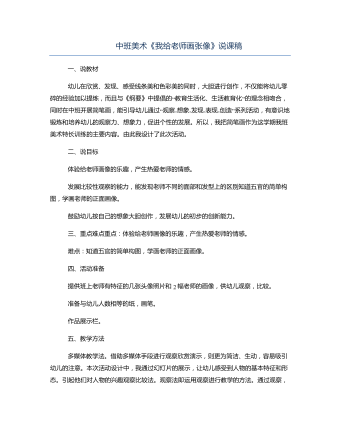
中班美术《我给老师画张像》说课稿
多媒体教学法。借助多媒体手段进行观察欣赏演示,则更为简洁、生动,容易吸引幼儿的注意。本次活动设计中,我通过幻灯片的展示,让幼儿感受到人物的基本特征和形态。引起他们对人物的兴趣观察比较法。观察法即运用观察进行教学的方法。通过观察,幼儿既形成了准确的造型印象,又把握了局部的细节特点。而在观察中进行比较,则能让幼儿更加直观地感受不同的创作手法带来的不同效果。本次活动中,为了让幼儿直接感受到人物的脸型,五官,发型的主要特征,以及简笔画的步骤及简单的人物的构图,色彩,特征等各方面的画法。让幼儿学会简单的构图和体验画人物的乐趣。
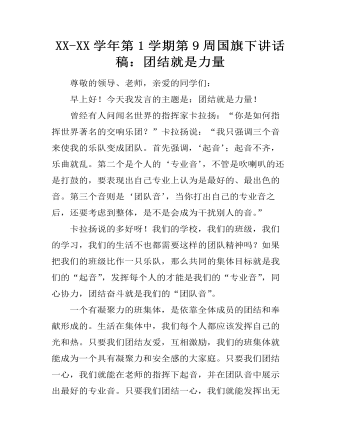
XX-XX学年第1学期第9周国旗下讲话稿:团结就是力量
尊敬的领导、老师,亲爱的同学们:早上好!今天我发言的主题是:团结就是力量!曾经有人问闻名世界的指挥家卡拉扬:“你是如何指挥世界著名的交响乐团?”卡拉扬说:“我只强调三个音来使我的乐队变成团队。首先强调,‘起音’;起音不齐,乐曲就乱。第二个是个人的‘专业音’,不管是吹喇叭的还是打鼓的,要表现出自己专业上认为是最好的、最出色的音。第三个音则是‘团队音’,当你打出自己的专业音之后,还要考虑到整体,是不是会成为干扰别人的音。”卡拉扬说的多好呀!我们的学校,我们的班级,我们的学习,我们的生活不也都需要这样的团队精神吗?如果把我们的班级比作一只乐队,那么共同的集体目标就是我们的“起音”,发挥每个人的才能是我们的“专业音”,同心协力,团结奋斗就是我们的“团队音”。
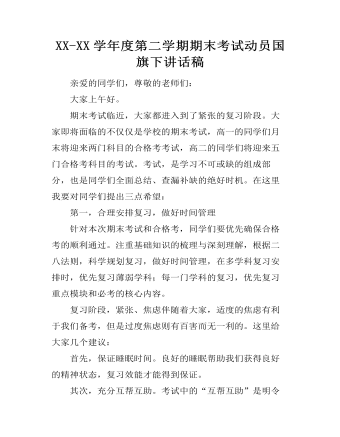
XX-XX学年度第二学期期末考试动员国旗下讲话稿
亲爱的同学们,尊敬的老师们:大家上午好。期末考试临近,大家都进入到了紧张的复习阶段。大家即将面临的不仅仅是学校的期末考试,高一的同学们月末将迎来两门科目的合格考考试,高二的同学们将迎来五门合格考科目的考试。考试,是学习不可或缺的组成部分,也是同学们全面总结、查漏补缺的绝好时机。在这里我要对同学们提出三点希望:第一,合理安排复习,做好时间管理针对本次期末考试和合格考,同学们要优先确保合格考的顺利通过。注重基础知识的梳理与深刻理解,根据二八法则,科学规划复习,做好时间管理,在多学科复习安排时,优先复习薄弱学科;每一门学科的复习,优先复习重点模块和必考的核心内容。复习阶段,紧张、焦虑伴随着大家,适度的焦虑有利于我们备考,但是过度焦虑则有百害而无一利的。这里给大家几个建议:
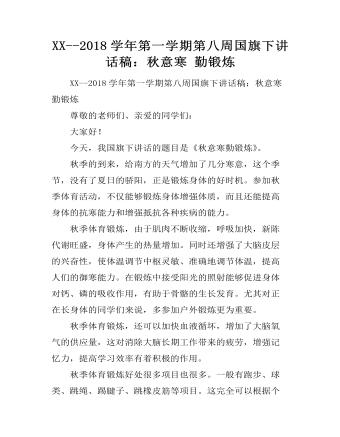
XX--2018学年第一学期第八周国旗下讲话稿:秋意寒 勤锻炼
XX--2018学年第一学期第八周国旗下讲话稿:秋意寒勤锻炼尊敬的老师们、亲爱的同学们:大家好!今天,我国旗下讲话的题目是《秋意寒勤锻炼》。秋季的到来,给南方的天气增加了几分寒意,这个季节,没有了夏日的骄阳,正是锻炼身体的好时机。参加秋季体育活动,不仅能够锻炼身体增强体质,而且还能提高身体的抗寒能力和增强抵抗各种疾病的能力。秋季体育锻炼,由于肌肉不断收缩,呼吸加快,新陈代谢旺盛,身体产生的热量增加。同时还增强了大脑皮层的兴奋性,使体温调节中枢灵敏、准确地调节体温,提高人们的御寒能力。在锻炼中接受阳光的照射能够促进身体对钙、磷的吸收作用,有助于骨骼的生长发育。尤其对正在长身体的同学们来说,多参加户外锻炼更为重要。
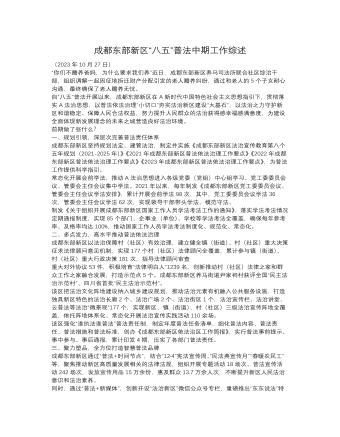
成都东部新区“八五”普法中期工作综述
六、在推动普法多样性上出实招加大全民普法力度,常态化开展“一月一主题”“法律七进”普法宣传活动,做强做优“东东说法”特色普法品牌,每月定期推出法治宣传小视频1期、法治推文8篇,充分利用线下活动与线上新媒体平台,营造全民尊法学法守法用法良好氛围。深化法治乡村建设,建立健全镇(街道)、村(社区)重大决策征求法律顾问意见机制,确保177个村(社区)法律顾问全覆盖,创建省级民主法治示范村(社区)不少于1个,新建法律之家与群众工作之家融合发展示范点3个,持续培育农村学法用法示范户,实现行政村学法用法示范户100%全覆盖。加强法治阵地建设,推进法治文化设施与公共文化服务设施一体规划建设,新建法治文化主题公园(广场、街区)等大型法治文化阵地1个。加强基层单位法治文化形象塑造,到2025年底,实现新区、镇(街道)、村(社区)三级法治文化阵地全覆盖,依托法治文化阵地体系化、常态化开展法治宣传实践活动。让法治之光照亮生活融入人心
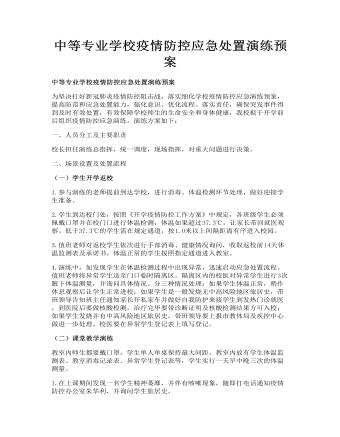
中等专业学校疫情防控应急处置演练预案
1.参与演练的老师提前到达学校,进行消毒、体温检测环节处理,做好迎接学生准备。2.学生到达校门处,按照《开学疫情防控工作方案》中规定,各班级学生必须佩戴口罩并在校门口进行体温检测,体温如果超过37.3℃,让家长带回就医观察。低于37.3℃的学生需在规定通道,按1.0米以上间隔距离有序进入校园。3.值班老师对返校学生依次进行手部消毒、健康情况询问,收取返校前14天体温监测表及承诺书。体温正常的学生按照指定通道进入教室。
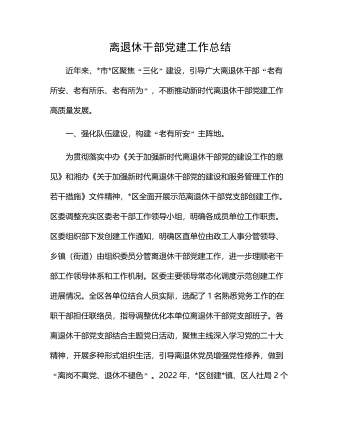
民族中学2023年体育工作开展情况总结
针对我校实情我们克服了场地小、器材少、上课班级人数多的众多不利因素,体育组制订了体育教师场地器材安排表,体育教师出操安全值勤表,从思想上组织上确保安全措施责任到人。教学过程中杜绝安全事故的发生。六、多方努力,齐抓共管,做好《学生体质健康标准》的测试、登记、上报工作《学生体质健康标准》是促进学生体质健康发展、激励学生积极进行身体锻炼的教育手段,是学生体质健康的个体评价标准,是《国家体育锻炼标准》在学校的具体实施,也是学生毕业的基本条件之一。为顺利完成学年度体育《标准》测试工作,提高我校体育《标准》成绩,学校在初期就制定了学校《体质健康标准》测试计划,要求各班级认真开展《标准》的训练和测试工作。在副校长xx的领导下,由体育组组长牵头,多方努力,齐抓共管,共同组织实施,高要求、高质量地完成了《学生体质健康标准》的测试、登记、数据录入及上报工作。



